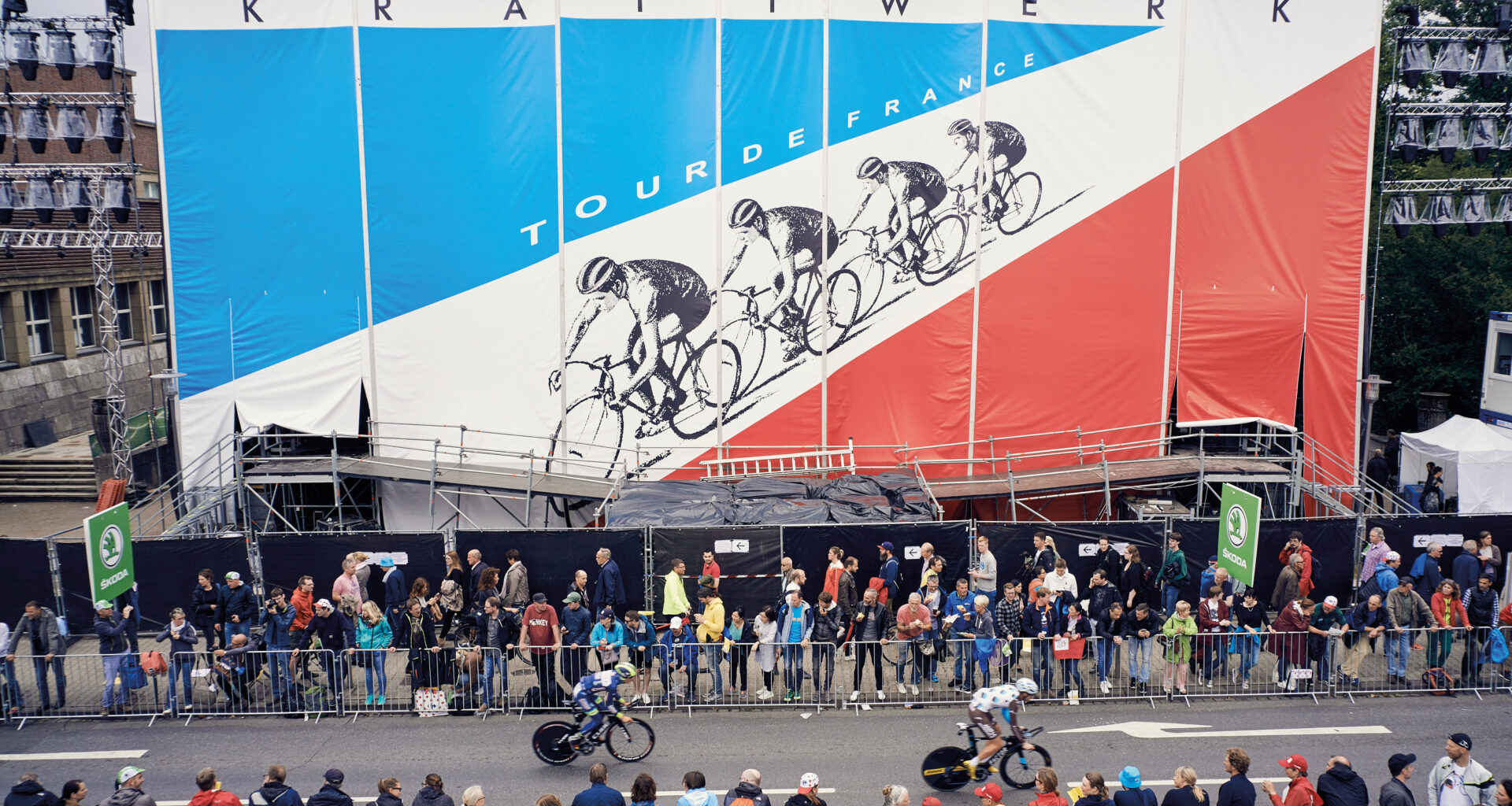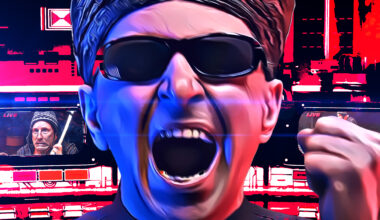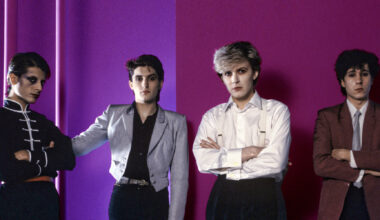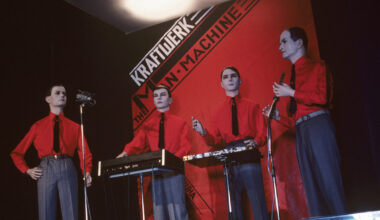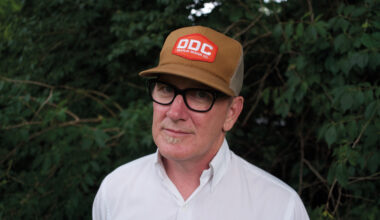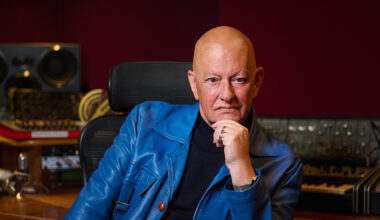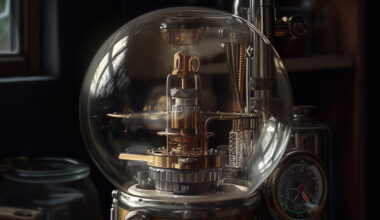Electronic Sound headed to Germany to catch Kraftwerk playing a huge outdoor concert in celebration of the Tour De France getting under way in Düsseldorf. It was a weekend of beer, bikes and Beuys…
Everywhere you look, there are bicycles. Cars tear down Düsseldorf’s streets, dense thickets of bikes racked on their roofs, and lycra-clad cycling enthusiasts navigate their way around on their expensive machines.
They probably pedalled here from The Netherlands. It’s only 200km away, after all.
To the rear of the Ehrenhof, an impressive stretch of wide boulevard flanked on one side by parkland and on the other by the NRW Forum, an art gallery devoted to photography and pop culture, a vast tarpaulin stretched across some scaffolding towers dominates the scene. The tarpaulin features a familiar image to any Kraftwerk fan: a cycling peloton of four riders on a red, white and blue background – the cover of Kraftwerk’s last studio album, 2003’s ‘Tour De France Soundtracks’. It’s the rear wall of a temporary outdoor venue being built to host what might be the ultimate electronic music experience: Kraftwerk playing live in Düsseldorf as part of the city’s hosting of the Grand Départ of the Tour de France.
To paraphrase Nigel Tufnel from Spinal Tap, how much more Kraftwerk could it be? The answer is none. None more Kraftwerk.
As the only pop group in the 114-year history of the Tour de France to devote an entire album to the world’s greatest bicycle race, it seems only right that, when the cycling circus hits Düsseldorf, Kraftwerk play a dirty great big outdoor concert in their home city. It might not be the most bike friendly place in the world (that would be Copenhagen or Amsterdam) and it might be pouring with rain most of the weekend, but Düsseldorf has gone complètement fou for the Tour de France.
Exploring the city the night before the big day, when the Tour de France time trials get under way and Kraftwerk play, the fun begins with a “beer safari” in the city’s old quarter, the Altstadt. Each bar in the Altstadt has its own micro brewery, like Füchschen (Little Fox), which has been here since the mid-17th century. The beer comes in small glasses that are continually refilled if don’t cover your glass with a beer mat. Don’t ask for water or wine, our guide tells us. Why? Because it’s not beer. One of our party does order wine. It takes about half an hour to materialise and is delivered with an indifference that borders on contempt.
Füchschen is an important meeting place for Düsseldorf’s thrill seekers. It’s located between the city’s celebrated Kunstakademie (Art Academy), which was established in 1762, and the building where the Creamcheese club once was. Both are within a one minute walk.
Kunstakademie star tutor Joseph Beuys, the artist who was something of a creative lightning rod for the city’s musicians and artists, especially in the 1960s and early 1970s, would drop in regularly for a beer or several, haunting this tight knot of streets.
Creamcheese is now an anonymous private building on Neubrückstrasse. The only exotic thing about it is the legend “Zum Neuen Schelfisch” (something to do with haddock) engraved into the stone doorway and the carved fish lying on top of the arch. But back in the 60s, this place was a hub of the German counterculture, where the bill was a permanent exhibition of installation art and “happenings”. Kraftwerk played their first gig here, Beuys performed here, and the club was considered significant enough for its interior to be recreated as an exhibit at the Guggenheim called ‘Zero: Countdown To Tomorrow, 1950s-60s’ in 2014. Creamcheese was Düsseldorf’s own Exploding Plastic Inevitable, where loud music, art and drugs came together in a combustible mix.
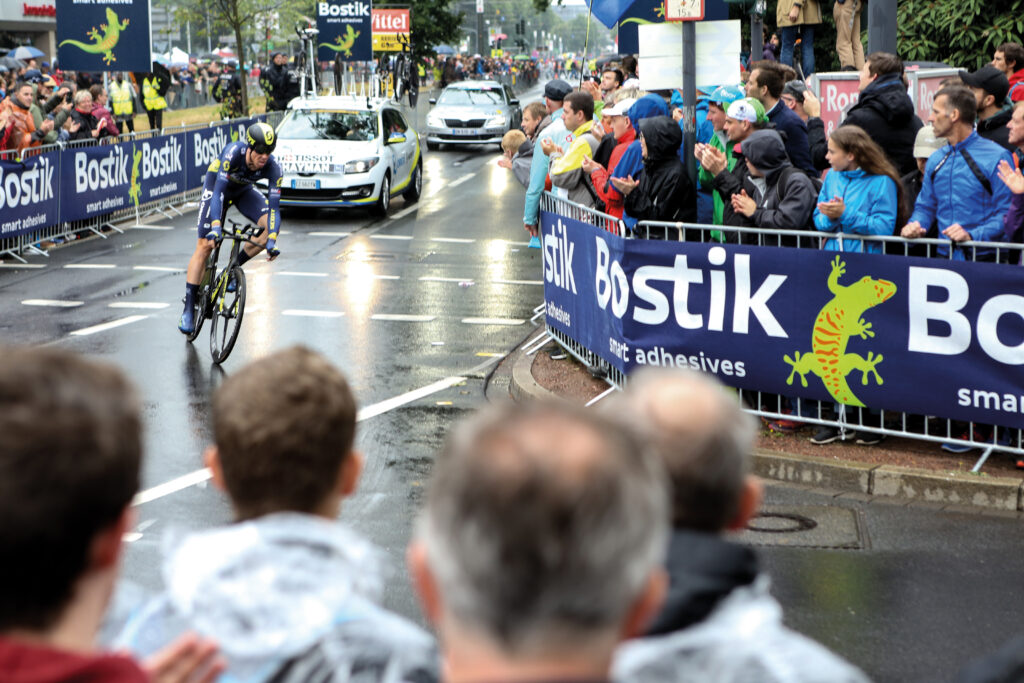
Joseph Beuys, who believed that “every human being is an artist”, taught at the Kunstakademie until he was fired in 1972. The authorities weren’t happy that he’d done away with an entrance exam or any qualification whatsoever for his course. When they barred a group of his students, Beuys and some of his associates occupied the academy’s offices.
That’s what got him the heave-ho. It didn’t stop him becoming one of the most important (and strange) artists of the 20th century, though.
These days, a few doors along from the Creamcheese location is Beuys Bar, a groovy little 2017 hangout for well-heeled revellers. The former wartime Luftwaffe pilot turned artist provocateur has become the subject of a themed bar. It’s a typically Düsseldorf move; this city is a place where making money, making art and making music seem interchangeable.
Just the kind of place that would produce a band like Kraftwerk.
Later that night, we gather at Brauerei Schumacher for dinner. I shake hands with a woman who smiles and introduces herself as Claudia. We start politely chatting about the weather (it’s still raining), before she tells me that she’s a singer and she’s been working with Wolfgang Flür. It gradually dawns on me that this is Claudia Brücken, formerly of 1980s German synth sorts Propaganda. She’s visiting family in Düsseldorf (she actually lives in London these days) and has just been in the studio with Wolfgang. Wolfgang himself is also here, enjoying a schnapps with some friends.
Later still, in a bar on the 11th floor of a hotel overlooking this compact but energetic city, Wolfgang palms me a small bottle of herbal schnapps, slaps a pair of headphones over my ears, and plays me the track that he and Claudia have recorded together. It’s called ‘Birmingham’. It’s the first time I’ve heard Britain’s second city eulogised in synthpop. I like it, but I’m not so sure about the schnapps, which burns my throat. Wolfgang tells me it’s 42 per cent proof.
Across the table from us in the bar are David Sanborn and Jennifer Huber, who have flown in from Tampa, Florida, to see Kraftwerk. They pass around a small book of wedding photos. They got married earlier this year in a Kraftwerk-themed ceremony, dressed in ‘Man-Machine’ red and black, their guests all similarly attired and with added 3D glasses. Jennifer is tearily overcome at meeting Wolfgang.
The evening blurs into a sensation of well-being and weirdness. As we depart, we ask Wolfgang if we’ll be seeing him the following night at the Kraftwerk gig. “No!” he chuckles. He’s seen them before.
The next day we visit Café Schicke Mütze, a café/shop/bicycle workshop tucked away in a little square. It was opened by Carsten Wien, a cycling freak who used to be in management at HMV. He then ran his own record shop before starting this place.
Like Ralf Hütter, Carsten has two passions: music and cycling. Bikes hang from the walls and lean against the counter. Mütze (cycling caps) dangle from the ceiling, clustered into artful arrangements. It smells a bit of rubber, but the coffee’s good. On sale among the standard branded bicycle clothing and accessories are Kraftwerk cycling jerseys, Kraftwerk cycling caps, and Kraftwerk bidons (that’s bike talk for plastic water bottles). The café organises year-round rides for both beginners and more hardened cyclists. Someone asks Carsten if he has ever ridden with Ralf Hütter. He hasn’t, but he knows a man who has.
Everywhere we go, Kraftwerk is in the air for you and me. On our way to catch a glimpse of the Tour de France time trials, which take place the day before the Grand Départ, we happen upon a small art gallery. Its sleek white interior has been entirely given over to exhibiting state-of-the-art racing bicycles from the German manufacturer Canyon. In pride of place is Canyon’s Kraftwerk bike. Canyon CEO Roman Arnold created the €10,000 machine with Ralf Hütter’s co-operation and the company produced 21 bikes for the public. They went on sale on 3 July and, like Kraftwerk gig tickets, sold out immediately.
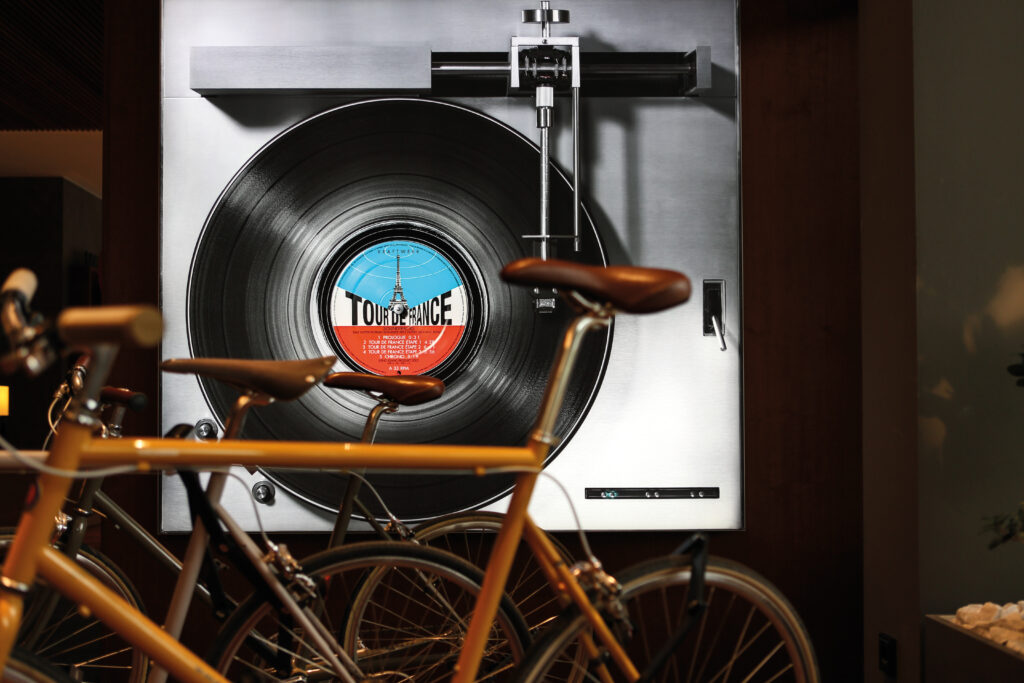
By 7.30pm, we’re making our way to the venue. Security checks bottleneck the crowds as they swarm in. There has never been a concert here before, so there are concerns that it might get a little chaotic, but this is Germany. Once past the barriers, there are pretzel and sausage vendors aplenty and, of course, lots of beer for sale. We sip our beer from souvenir Kraftwerk beakers. You pay an extra €2 for your first drink to get the branded cup. If you want another drink, you use the same cup, and you can take it home with you at the end of the night. It’s another money/art intersection and a smart way to avoid the awful post-festival mountain of crushed plastic.
The souvenir beakers makes me think of Florian Schneider’s campaign to stop waste plastic being dumped in the ocean, his only public concern since he jumped the Kraftwerk ship more than 10 years ago. He released a track about this particular environmental problem in 2015, ‘Stop Plastic Pollution’, a collaboration with Dan Lacksman of Telex. I gaze around the tightly packed crowd and wonder whether Herr Schneider is on the guest list tonight. Perhaps not, given that his last interview described Kraftwerk as having “become historic and is now exposed in museums”. I think he meant “exhibited” but here, surrounded by art galleries, you get the point.
Air are the support band, which is the first time I’ve encountered such a phenomenon at a Kraftwerk gig, and they’re sublime. The sun comes out while they’re playing and Jean-Benoît Dunckel’s mastery of a Korg MS-20 is in full effect, amplified as it is through Kraftwerk’s hugely impressive surround sound PA system. “I am a French robot,” intones Nicolas Godin as he warms up his vocoder, to much general amusement. A storming version of ‘La Femme D’Argent’ closes Air’s set and, in fairly quick order, Kraftwerk are onstage.
They open with a trio of tracks from 1981’s ‘Computer World’. Ralf sings in German and the sound is pristine.
As expected, as the set progresses it is weighted heavily towards the ‘Tour De France Soundtracks’ album (or ‘Tour De France’ if you prefer the reissue title). Despite some strange drops in the audio (the voices repeating the names of the locations of nuclear disasters during ‘Radioactivity’ for example), it’s a triumph of surround sound in an outdoor location.
The bass seems to be travelling through the crowd at waist height, flapping trouser legs as it goes, and the speakers that ring the Ehrenhof, plumbed into the scaffolding above us to our left and right every few metres, carry the likes of ‘Metal On Metal’ and ‘Numbers’ with mind-spinning clarity.
The visuals are 3D, but the sound is too. It’s deeply impressive.
Inside the NRW Forum, the building to our right as we’re watching Kraftwerk manifest itself as an outdoor immersive 3D experience, there is a photography exhibition called ‘Mythos Tour De France’. It features photography of the Tour taken over the decades by various photographers, including Magnum founder Robert Capa and several Düsseldorf school snappers. The “Düsseldorf school” is a term used to describe a handful of photographers who studied at the city’s Kunstakademie in the 1970s under the celebrated artists Bernd and Hilla Becher. An example of the Bechers’ work will be familiar to the more committed Kraftwerk fans from the group’s eponymous first album, the one with the red traffic cone on the cover. That stark black and white shot of an electricity power station on the inside across the gatefold? That’s by Bernd and Hilla Becher.
It’s an easily overlooked but crucial indicator as to how deeply Kraftwerk and Düsseldorf are entangled.
Kraftwerk couldn’t have happened anywhere else. Kraftwerk’s Düsseldorf, like the group itself, exists in the intersection between a bourgeois city of commerce and its highly regarded art academy. The latter became a focal point for the post-war generation to re-invent Germany through both serious art and pop culture. The former is all about making coin.
Düsseldorf in the 1970s was the right place to be if you were minded to create a musical expression of ideas that would beam itself forwards from a sturdy platform of academic rigour and counterculture rebellion.
Whether Ralf Hütter circa 1970, struggling with Florian Schneider to birth their messy avant-duo, could envisage the Kraftwerk of 2017, we will never know. But if we could take a time machine back to Creamcheese and ask him if he had the future mapped out, we’d like to think his reply would be, “Yes. And it will have something to do with bicycles too…”
Kraftwerk’s ‘3-D The Catalogue’ vinyl, CD and DVD boxsets are out Kling Klang/Parlophone
